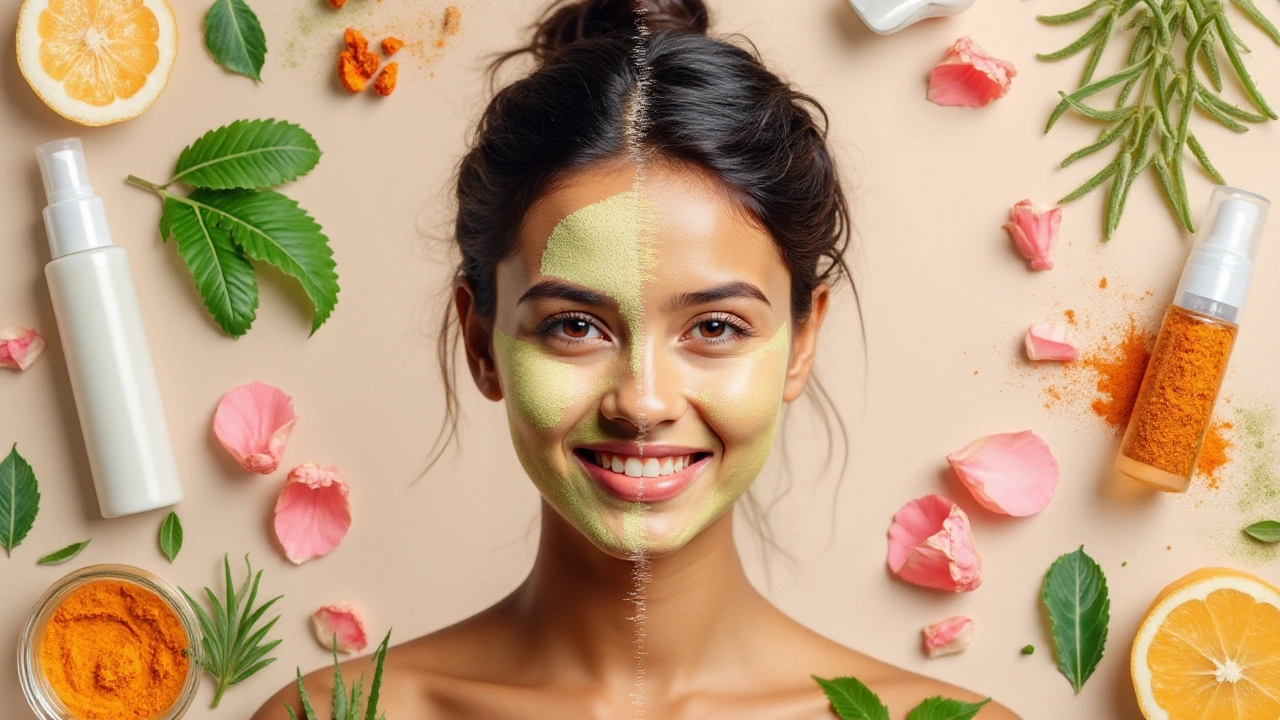
Taking care of your skin doesn't have to be complicated. People often get lost in the endless aisles of skincare products, but the truth is that effective skincare begins with the basics. Whether you’re new to skincare or looking to refine your routine, tailoring the fundamental steps to your skin type can make a big difference.
The simplest routines are often the most effective, focusing on cleansing, exfoliating, and moisturizing. Coupled with proper sun protection, these elements form the backbone of a healthy skincare regimen. This guide will walk you through the essentials, offering tips and insights to help you achieve the skin you’ve always wanted.
Cleansing Essentials
Cleansing is the cornerstone of any skincare regimen, serving as the primary step toward clear and healthy skin. Whether worn-out by a hard day's sweat, makeup, or pollution, our skin collects debris that needs effective cleansing. An important fact many people often overlook is the impact of the cleanser's pH balance on our skin. Our skin's natural pH is slightly acidic, around 5.5, so it's essential to choose a cleanser that mirrors this balance, closing the gap to avoid irritation and dryness. Water-based cleansers are generally advisable for oily and combination skin types, while cream-based cleansers work best for dry skin as they help lock in moisture.
Double cleansing is a practice that has caught up in recent times, originating from the thorough skincare routines of Korean beauty regimes. This system involves using an oil-based cleanser followed by a water-based one. The idea here is that the first cleanser removes makeup, sunscreen, and excess oils, while the second removes grime and sweat. A 2018 study published in the Journal of Dermatology reveals that individuals practicing double cleansing experienced fewer breakouts and clearer skin over six weeks. Ensure you are gentle; scrubbing too hard can cause micro-tears, leading to inflammation. Patience and a gentle touch are key when building up patience with a new routine as results can glean over time.
"Cleansing is not just about removing makeup; it’s the first step to nurturing your skin and preparing it to receive the nutrients that follow," says Dr. Marisa Garshick, a board-certified dermatologist.
It's important to recognize the right temperature of water to use. Confusing as it might be, hot water may feel satisfying but strips the skin of its natural oils, leading to dryness and increased sensitivity. Opting for lukewarm water is a balanced approach, opening pores slightly for a deeper cleanse while maintaining the skin's protective barrier. Equally crucial is the choice of towels – softer materials reduce the risk of abrasion; always gently pat-dry rather than rubbing vigorously.
To cleanse effectively, start with dry hands and a dry face for oil cleansers. This allows the oil to bind effectively with the makeup and oils on your face. Then, emulsify with a splash of water, turning the oil into a milky solution to rinse away everything seamlessly. For foaming cleansers, it's best to foam up the product in your hands before applying it to your face, which ensures even distribution and activation of the product on contact with water.
Cleansing routines can be a personal experience, influenced by lifestyle, environment, and personal preferences. Developing a routine that complements your skin type without stripping it of necessary hydration and oils is pivotal. Those with sensitive skin can benefit from fragrance-free cleansers, minimizing irritation risks. Mindful choices combined with gentle, consistent practices create the foundation for effective skincare and ultimately enhance your skin’s natural glow.

Exfoliation Techniques
Embarking on a skincare journey is much like any other voyage; knowing where to start makes all the difference. Exfoliation, an essential step in any effective skincare routine, involves removing dead skin cells from the surface of your skin, revealing a brighter, more even-textured you beneath. But how do you proceed with exfoliation without overdoing it? With a range of options available, it’s crucial to choose a technique that suits your skin type. Dermatologists agree that exfoliating one’s skin can alleviate clogged pores, reduce the appearance of pesky breakouts, and enhance the success of other skincare products by allowing them to penetrate more deeply. Chemical and physical exfoliation are the two primary methods, each offering unique benefits and challenges.
Physical exfoliation is the more traditional approach, involving manually scrubbing dead skin cells away. Think of exfoliating brushes and exfoliant scrubs. While it can provide immediate smoothing, it’s important not to overdo it, as aggressive scrubbing can cause micro-tears on the skin surface. Now, if you’re the kind who enjoys a soothing spa-like ritual, physical exfoliation might just be your preferred option. Most skin types can benefit from a once or twice-a-week ritual, but it's those with sensitive or acne-prone skin who should tread carefully.
Chemical Exfoliators: A New Frontier
Ah, the wonders of science! Chemical exfoliants, meanwhile, rely on mild acids to dissolve dead skin cells and other debris. They include alpha hydroxy acids (AHAs), like glycolic acid and lactic acid, as well as beta hydroxy acids (BHAs) such as salicylic acid. Consider glycolic acid, for example, which not only lightens pigmentation over time but is also a fierce ally against the signs of aging. A pro tip: for those new to chemical exfoliants, starting slow and opting for products with lower acid concentrations can help your skin adjust comfortably.
Dr. Loretta Ciraldo, a board-certified dermatologist, remarks that "using a blend of both AHAs and BHAs can provide compounded benefits."
This means not just exfoliating the surface but also penetrating deep into the pores, clearing out pesky blackheads and reducing inflammation. A skin combination you can rely on for achieving a truly healthy glow.
| Exfoliation Type | Ideal Frequency | Suitable for |
|---|---|---|
| Physical | 1-2 times a week | Most skin types |
| Chemical | 2-3 times a week | Oily/combination skin |
While experimenting with different exfoliation techniques, listen to your skin’s needs. Redness, irritation, or burning sensations are signals to pull back on frequency or intensity. Bear this in mind: exfoliation is intended to reveal the best of your skin, not hide it behind damage. In today’s world where trends change like seasons, the consistency of a thoughtful skincare routine anchored by regular exfoliation remains timeless.
The deliberately slow approach can gradually illuminate a more vibrant complexion. So why not treat your skin as kindly as you would your prized orchid collection? In just a few mindful steps, engaging in a balanced exfoliation regimen can lead you closer to achieving that long-desired radiance. By integrating exfoliation into your skincare regimen, you’re not just cleaning — you're celebrating your skin's journey, honoring its ability to rebuild and renew, giving yourself a fresh start each day.

Moisturizing Methods
Moisturizing is a critical step in any skincare regimen, yet it often gets overshadowed by more glamorous treatments. At its core, moisturizing involves replenishing the skin's natural barrier, ensuring that it remains hydrated and resilient against environmental stressors. The skin is the body's largest organ, and keeping it healthy means keeping it moisturized. There are three primary types of moisturizers: humectants, emollients, and occlusives. Humectants, such as hyaluronic acid, attract water to the skin's surface, enhancing hydration. Emollients, like shea butter and ceramides, smooth and soften the skin by filling in the spaces between skin cells. Lastly, occlusives, such as petroleum jelly, lock in moisture by creating a physical barrier.
Choosing the right moisturizer depends on your skin type and the climate in which you live. For those with oily skin, lightweight, non-comedogenic formulas work best. These products hydrate without clogging pores. For dry skin, thicker creams with emollients and occlusives provide the extra nourishment needed to combat flakiness and irritation. Individuals with sensitive skin should prioritize fragrance-free and hypoallergenic options to minimize potential irritation. If you live in a cold or dry climate, your skin may benefit from a more intensive moisturizing routine during the winter months to prevent dryness.
Application Techniques
When it comes to applying treatments, timing is everything. Experts recommend moisturizing immediately after cleansing to trap in as much moisture as possible. Some suggest doing it within three minutes — often referred to as the "three-minute rule." This technique ensures that the moisture you've just added to your skin doesn't evaporate. A study in dermatological practice indicates that moisturizing in this manner can lead to improved skin health over time. Application doesn't stop at the face; the neck and décolletage also require attention, as these areas are prone to signs of aging.
"The best way to keep your skin hydrated is by using the right moisturizer and applying it correctly," advises Dr. Lila England, a dermatologist and skincare expert.
Every season brings its own skincare challenges, making product rotation a prudent approach. In warmer months, gel-like or water-based moisturizers can prevent excess oiliness, while during winter, richer creams help stave off dryness induced by indoor heating. Many people wonder if night creams are a marketing gimmick, but these products often encompass ingredients, like retinol, that necessitate nighttime use to avoid sun sensitivity. It's also worth considering using products with SPF during the day to add an extra layer of protection against sun damage.
Being mindful about the ingredients can greatly benefit your routine. Natural extracts, essential oils, and vitamins have significant roles to play. Vitamin E, for instance, is a well-regarded antioxidant that promotes skin repair and diminishes the harmful effects of UV rays. Shea butter, rich in fatty acids and vitamins, acts as an emollient, while peptides help in reinforcing the skin barrier. These potent ingredients, combined in the right formulations, can transform your skin, leaving it soft and glowing. Monitoring for allergens is key, especially when experimenting with new products.
Today's market offers a plethora of choices, from traditional creams to cutting-edge hydrogels and serums. Testing out different options can help identify the perfect fit. Always conduct a patch test when trying a new product to avoid adverse reactions. Additionally, don't overlook dietary hydration; consuming plenty of water supports optimal skin health from the inside out. By complementing topical moisturizing efforts with adequate water intake, you create a powerful combination in the fight against dehydrated skin.

Sun Protection Strategies
Protecting your skin from the sun is not a seasonal concern; it’s an everyday commitment. The ultraviolet (UV) rays from the sun are one of the leading causes of skin damage. They can cause everything from sunburns to premature aging and contribute significantly to skin cancer risks. Knowing how to safeguard your skin effectively starts with understanding the different types of UV rays. UVA rays penetrate the skin more deeply and are primarily responsible for long-term damage like wrinkles and age spots, while UVB rays cause most sunburns. Both are harmful, so you must consider them when choosing sun protection strategies.
Regular use of broad-spectrum sunscreen is among the most effective sun protection strategies available. You should look for sunscreens offering a Sun Protection Factor (SPF) of at least 30, which blocks about 97% of UVB rays. For maximum effectiveness, apply sunscreen about 15 minutes before heading outside. It’s crucial to be generous in application – adults should use about an ounce, or a shot glass worth, to cover all exposed skin. Don’t forget commonly missed spots like the tops of your ears, the back of your neck, and your feet if you’re wearing sandals. Reapplication is another key; it should be done every two hours, and more frequently if you’re swimming or sweating.
While sunscreen is vital, it shouldn’t be your only defense line. Wearing protective clothing is an excellent additional layer of defense. Look for garments made from tightly woven fabrics, or consider investing in clothing with built-in SPF protection. Wide-brimmed hats can help shield your face, ears, and neck. Don’t overlook a good pair of sunglasses; UV rays can also damage your eyes, and sunglasses with UVA and UVB protection help protect against cataracts. Seeking shade during the sun’s peak hours – usually between 10 a.m. and 4 p.m. – is another practical approach to minimize exposure.
Several studies underscore the importance of these strategies. For instance, research published in the Journal of the American Academy of Dermatology suggests that consistent sunscreen use can significantly reduce the risk of melanoma. According to the Skin Cancer Foundation, even on cloudy days, up to 80% of UV rays can penetrate the clouds, making protection critical despite the weather.
“Sunscreen is your last line of defense. It works best when combined with other sun-safe behaviors,” notes Dr. Emily Weiss, a renowned dermatologist and author.
Don’t forget, protecting your skin from sun damage extends beyond just applying sunscreen. Daily habits and lifestyle choices contribute too. Opt for shade whenever possible, and utilize tools like umbrellas when you’re outdoors for extended periods. Educate yourself on how to spot UV alerts in weather forecasts, as they can guide you in planning outdoor activities safely. Remember that reflective surfaces like water, snow, and sand can increase your exposure, so be extra cautious around them. These comprehensive measures combined ensure that you’re both protecting your skin and reducing the risk of damage effectively.
Effective sun protection strategies can make a huge difference in the health and appearance of your skin. By incorporating protective clothing, broad-spectrum sunscreens, sunglasses, and shade into your routine, and by educating yourself about UV radiation, you are empowering yourself to make smart decisions for your skin. These efforts will not only help maintain that youthful glow but also provide a critical defense against the long-term effects of sun exposure.





